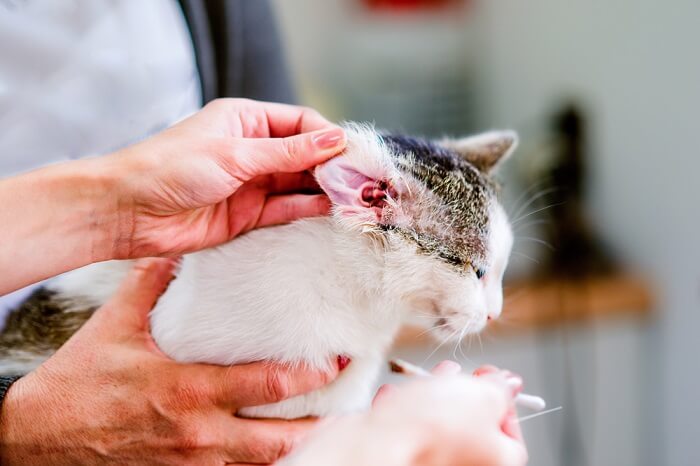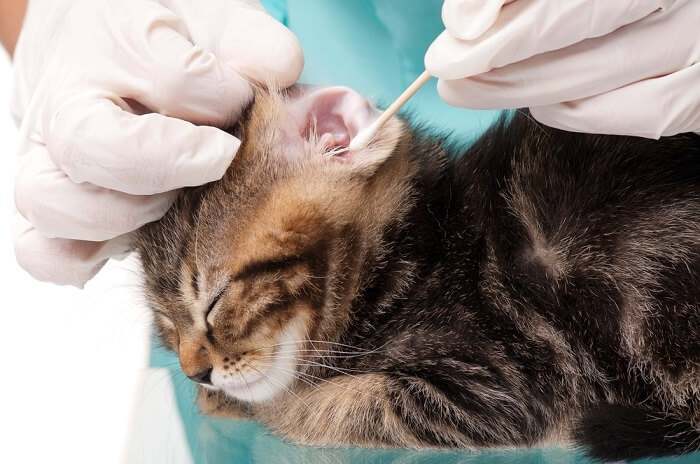
We’re all familiar with the sight of a cat crouched hunting their prey, utilizing their excellent eyesight and reflexes, but did you know that cats also have a remarkable sense of hearing?
In fact, your cat’s hearing is better than humans and dogs!
This might not come as a surprise to some of you, who have noticed that your cat suddenly appears at the slightest sound of the food tin opening or can hear your car pull into the driveway. You may have already experienced your cat’s amazing hearing capabilities.
A domestic cat’s sense of hearing is very impressive and also very complex. To understand their hearing, it’s best to understand the structure of a cat’s ear first and how sound travels into their ears.
Structure of a Cat’s Ear

The structure of a cat’s ear is very important. As you know, cats have large, pointy external ears (ear pinnae). These pinnae act as little radars that swivel to pick up noises and funnel them into the ear canal.
From there, the sound waves hit the eardrum and make them vibrate, sending these through to the cochlea (organ of hearing). The cochlea sends signals to the brain to register the sounds and the cat reacts to the noise.
The pinnae have 32 muscles to help them rotate to pick up noises. They can move independently of each other (the ears can move in different directions) and they can rotate up to 180 degrees. This helps them to pinpoint where different sounds are coming from.
The pinnae also include a cute little pocket, called Henry’s pocket, at the side of the ear. It doesn’t have any particular function, but sometimes it can harbor little mites that your vet may look for if your cat is itchy.
What’s Inside the Ear?

If your cat’s ears are dirty, schedule a visit with your vet to check for infection, ear mites or other issues.
Internally, the ear has an outer, middle and inner ear. The outer ear is made up of the pinnae and the part of the ear canal that you can see when you look into your cat’s ear.
The middle ear contains the eardrum and a small air-filled chamber. This chamber contains three little bones: the anvil, stirrup and hammer.
The inner ear contains the cochlea (organ of hearing) and the vestibular system. The vestibular system is responsible for balance, which as we know, cats are well known for.
I’m sure we’ve all seen a cat walking along a fence or wall very gracefully without losing balance. This is an important feature of the inner ear; ear problems can cause issues not only with hearing, but also with balance.
How Far Can Cats Hear?

Cats have a hearing range of 45 Hz to 64 kHz. This is a wider range compared to dogs (67 Hz to 45 kHz) and humans (64 Hz to 23 kHz). This means cats can hear above a range of 10.5 octaves, compared to 9.3 in humans. Cats are particularly good at hearing higher-pitched sounds and high frequencies.
It’s hard to appreciate how far away a cat can hear, as this depends on multiple factors, such as amplitude, noise level and environmental factors. Further studies are needed to determine the distances that cats can hear, but there’s no doubt that they can hear at great distances over several kilometers with certain sounds.
We do know that from a distance of three feet, the cat can distinguish sounds that are being made only three inches from each other. Imagine two mice standing three inches apart from each other, three feet away from a cat, making noises. The cat will be able to tell which mouse is making what noise. As you can imagine, this would be extremely useful trying to locate prey!
Cats can also hear sounds four to five times farther away compared with humans. This isn’t surprising, as cats often react to sounds that we can’t hear yet (e.g., a visitor approaching the house, the sound of thunder, etc.).
Do All Cats Hear This Well?

Cats have 32 muscles in their ears that allow them rotate to pick up noises, much like radar.
Although cats are lucky to have amazing hearing abilities, some cats have hearing impairments or no hearing at all resulting in permanent deafness.
White cats are particularly prone to congenital deafness (present from birth), due to an autosomal gene W (for white). In some cats, this can cause degeneration of the auditory apparatus (the hearing portion) of the inner ear.
Hearing impairments can occur in one or both ears. White cats with two blue eyes, are three to five times more likely to be deaf than a white cat with two non-blue eyes. BAER (brainstem auditory evoked response) testing can be performed on white breeding cats to check for deafness. White deaf cats shouldn’t be bred due to the genetic nature of the deafness.
Apart from white cats, other cats can lose their hearing as they age or due to certain health conditions that affect the ears, which we’ll discuss below.
Ear Maintenance: How Do We Keep the Ears Healthy?

A normal, healthy cat should have clean ears that don’t need any regular cleaning. If your cat’s ears seem clean and aren’t bothering your cat, there’s no need to intervene.
However, some cats can develop a buildup of wax in the ears due to a variety of reasons. In these cases, it’s beneficial to clean the ears regularly with an approved ear cleaner (ideally from your vet. First, bring your cat in for a veterinary exam to rule out any ear infection and to ensure patency of the eardrum (it’s not advisable to use ear cleaners if this is the case, unless prescribed by your vet).
What Problems Can Occur With the Ears?

Your veterinarian may want to swab the ears to check for bacteria or ear mites.
We’ve discussed the amazing hearing abilities that cats have, but what happens when these ears develop problems?
Ear infections, are one of the most common overall ailments seen in veterinary practice and in my opinion, the most common problem encountered with pet ears.
Otitis externa is the most common type, which basically means that the infection is in the outer ear canal. This is usually diagnosed with cytology (looking at the cells in the ear under a microscope) and often treated by your vet with ear cleaning and appropriate antibiotic drops.
More serious infections include otitis media and otitis interna, which involve the ear drums and inner portions of the ear. Severe infections of this type can cause issues with balance and spatial awareness by affecting the vestibular system in the ear. These types of infections require more tailored and advanced treatments by your vet.
Apart from infections, other common conditions that can affect the ears include:
- Parasites, (e.g., ear mites)
- Allergies
- Foreign material in the ear (e.g., grass)
- Hematomas
- Solar dermatitis (sun damage)
- Polyps
- Cancer
Less common ear issues include:
- Immune mediated conditions (e.g., pemphigus)
- Alopecia (hair loss)
- Vasculitis (inflammation of the blood vessels)
- Sebaceous adenitis
Signs of ear issues in your cat can include:
- Scratching the ears
- Rubbing the ears on the floor
- Redness or hair loss on the ear pinnae
- Discharge visible in the ear canal
- Cuts around the ears (caused by scratching)
- Bad odor from the ear
- Head shaking
- General irritability/pain
- Reduced appetite
- Change in behaviour
- In severe cases, wobbly and uncoordinated walk or a head tilt
Conclusion

Cats have amazing hearing. They can hear better than us and even dogs! Cats can hear at higher frequencies, so we should be mindful of noises that could startle them (e.g., vacuum cleaner, loud music and hair dryers).
Cats usually don’t need any intervention with their ears, but sometimes they can develop ear infections or other ear conditions that need veterinary attention. If in doubt, get your cat checked out by your vet.
Now that you know how well cats can hear, pay close attention to your cat the next time you make a little noise and watch how their ears react. You’ll be amazed at how well they can hear!







